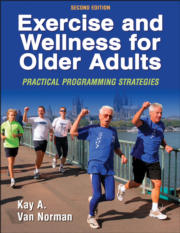|
Resistance band exercises improve older adults' upper- and lower-body strength
 
|


Resistance bands can be used to develop both upper- and lower-body strength. When working on upper-body strength, be sure your participant keeps her elbow next to or in front of, rather than behind, her body. To avoid painful impingement of the shoulder joint (pinching the ligaments in the joint), keep the elbow in front of the body while performing strength moves involving the shoulder joint. A strip of resistance band approximately 3 feet (about 1 meter) long works well for the following exercises. Frequently remind exercisers to hold the band properly by keeping the wrist locked straight rather than flexed either forward or backward.
- Biceps Curl: Exercisers place the right foot on one end of the band and grip the other end with the right hand, keeping the wrist locked straight (avoid hyperextending the wrist), and then flex the elbow to bring the right hand to the right shoulder (biceps curl) (figure 5.11). The number of repetitions will depend on the strength of the participants and the resistance of the band (4-10 times is a good range). Repeat for the left arm.
- Chest Press: Have participants place the band behind the back and grasp one end of the band with the right hand and the other end with the left hand. With elbows touching their sides, they slowly push their arms out to the front to extend the elbows and then slowly flex their elbows to bring them back to the starting position.
- Triceps Press: Participants grasp one end of the band with the right hand against the chest. They grasp the other end of the band with the left hand (6-8 inches [15-20 centimeters] from the right hand). Keeping the left elbow just below shoulder level and the forearm parallel to the floor, exercisers press the left hand forward, extending the elbow (figure 5.12). Then they slowly return to the starting position. Repeat 4 to 10 times, and then repeat with the left arm.
- Upper-Back Row: Participants place one end of the band under one foot grip the other end, and, with their elbows extended straight down and palms facing back, flex the elbows and pull toward the back (avoid pulling elbows behind the back) (figure 5.13), and then lower slowly to a straight arm. This can also be done with both arms at once by placing the middle of the band under both feet. Participants should do 4 to 8 repetitions.
- Brake Push: Participants place the left foot in the middle of the band and grasp one end with the right hand and one end with the left hand. They bring the left knee up toward the chest and pull their elbows to the sides (figure 5.14). Keeping elbows at the sides, participants push down with the left foot, extend the left knee (similar to a driver stepping on the brake pedal), and then slowly flex the knee again to return to the starting position. The number of repetitions (4-12) will depend on a participant’s quadriceps and arm strength. Repeat the entire sequence with the right leg.
- Knee Extension: The exerciser ties the ends of the band into a bow (forming a circle or loop), places the loop around the right ankle, and then puts the left foot into the loop in front of the right foot (for best results, the right foot should be slightly back under the chair) (figure 5.15). Participants should perform 4 to 12 left knee extensions while keeping the right leg stationary (as an anchor point). Repeat the exercise with the left leg as the anchor point and the right leg performing the knee extensions.
Caution: Instruct participants not to stand up with the feet inside the band. 



|
|